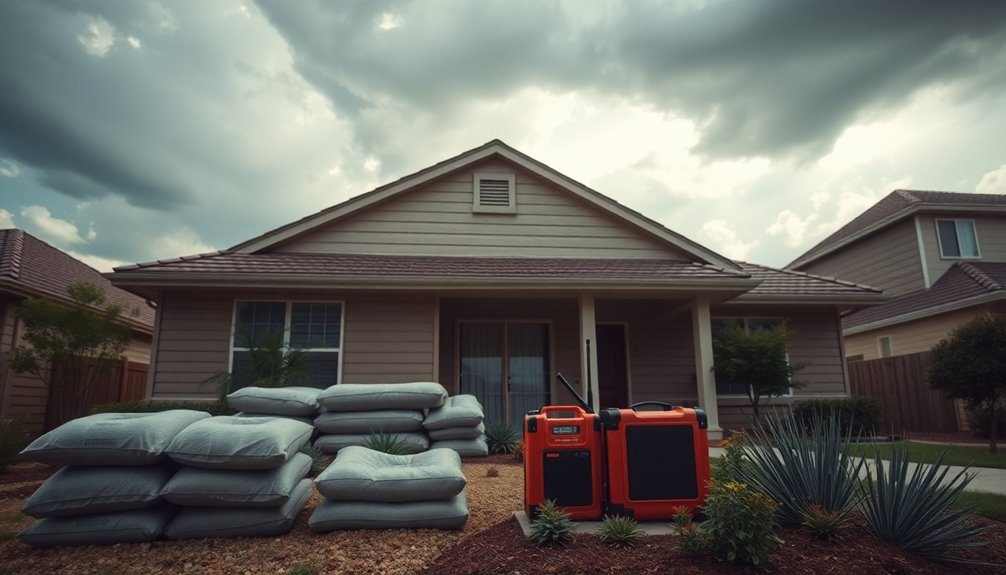Preparing your home for natural disasters is vital. Start by reinforcing doors and windows with sturdy locks and impact-resistant materials. Use sandbags to protect against floods by stacking them around vulnerable areas. Secure outdoor furniture to prevent hazards during storms. Regularly maintain your trees and landscaping to minimize risks. Create an emergency plan and kit with essential supplies. Finally, elevate valuable items and important documents to avoid damage. There's more to reflect upon for thorough preparedness.
Key Takeaways
- Reinforce doors and windows with heavy-duty locks, impact-resistant materials, and plywood to withstand high winds and flying debris.
- Use sandbags around doors and vulnerable areas to divert water during heavy rains and flooding events.
- Secure outdoor furniture by tying it down or moving it indoors to prevent it from becoming hazardous projectiles.
- Create an emergency plan and assemble a kit with essential supplies, including food, water, medications, and a communication device.
- Elevate electronics and important documents to prevent damage from floodwaters and protect them in waterproof storage.
Reinforce Doors and Windows
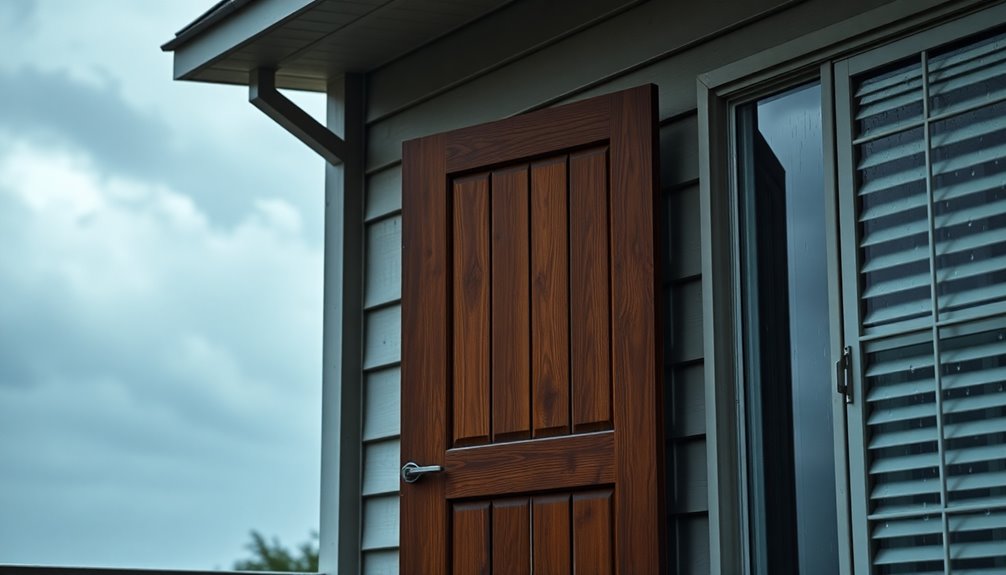
Reinforcing doors and windows is essential for protecting your home during natural disasters. You should reinforce doors with heavy-duty deadbolt locks and sturdy door jambs to withstand high winds and prevent forced entry.
Installing impact-resistant windows or storm shutters can safeguard against flying debris, reducing the risk of breakage. If storms are approaching, consider using plywood boards, at least ⅝ inch thick, to cover windows and glass doors for added protection.
Make sure all exterior doors are solid core or metal to enhance strength and resistance against wind pressure.
Finally, check for gaps around windows and doors, sealing them with weather stripping or caulking to prevent damage from water infiltration and boost energy efficiency.
Use Sandbags for Flood Protection
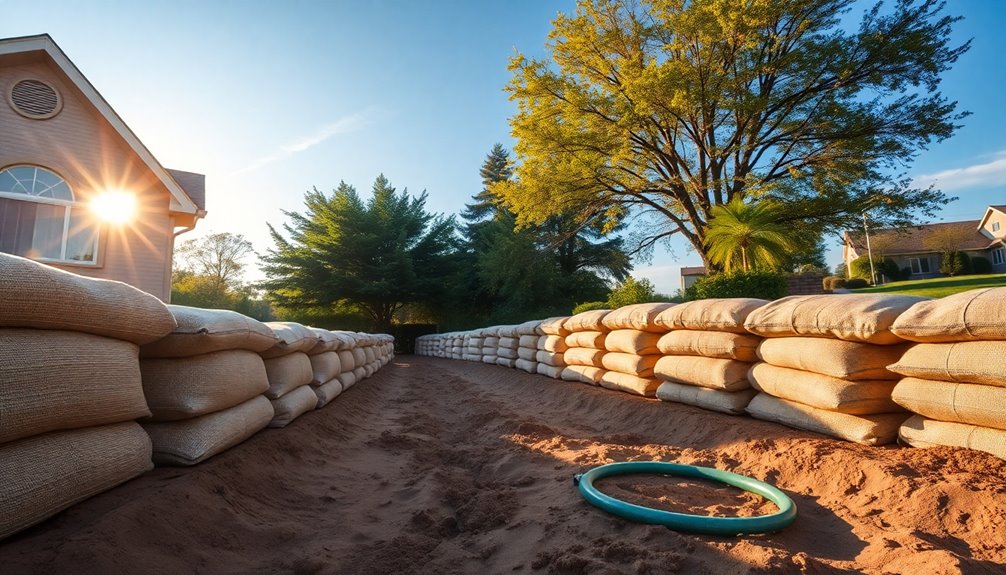
After securing your doors and windows, it's time to contemplate how to protect your home from flooding, especially if you live in a flood-prone area.
Sandbags are an effective way to provide flood protection during severe weather. Here are some tips for using them:
- Stack sandbags at least one foot high around doors and vulnerable areas to divert water.
- Store sandbags in your garage before a storm to avoid last-minute purchases.
- Position sandbags tightly together with no gaps to maximize effectiveness against incoming water.
For enhanced safety, consider using sandbags in combination with plastic sheeting and additional protective measures.
This can help minimize additional damage and keep your home safe during heavy rains and flooding events.
Secure Outdoor Furniture and Items
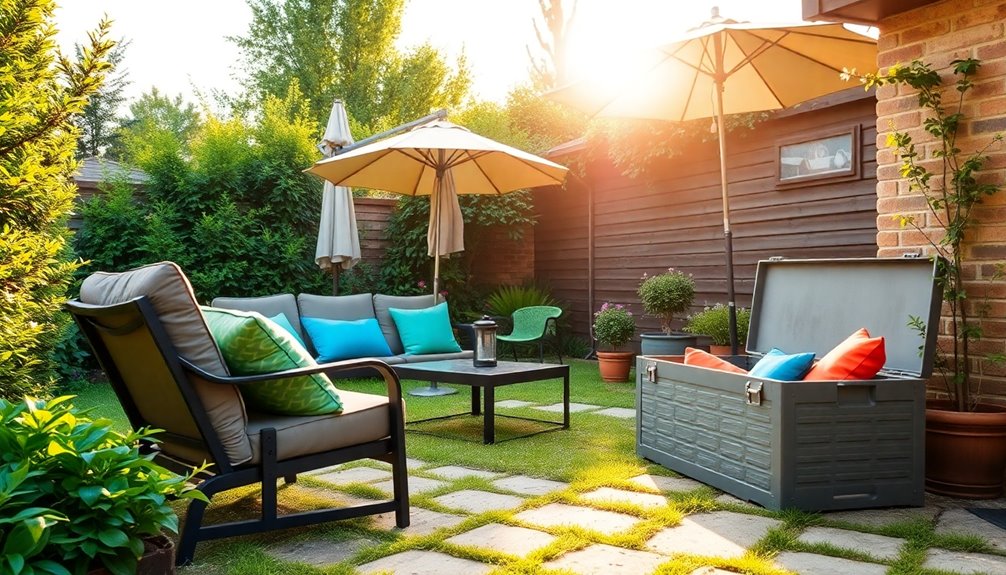
To keep your home safe during a natural disaster, it's essential to secure outdoor furniture and items.
Tie down any large pieces and move smaller items like toys and grills indoors.
Tie Down Furniture
When preparing your home for natural disasters, securing outdoor furniture is essential. High winds can turn these items into dangerous projectiles, so it's vital to tie them down.
Use heavy-duty straps or ropes to secure larger pieces. Additionally, move lightweight items indoors to minimize risk.
Here are three tips to help you secure your outdoor furniture:
- Anchor large furniture like tables and chairs to a solid structure.
- Store small items like garden decorations and grills inside.
- Regularly check and maintain your outdoor furniture to guarantee it's in good condition.
Remove Loose Items
As storms approach, it's crucial to remove loose items from your yard that could become hazardous projectiles.
Start by securing outdoor furniture; tie it down or bring it inside to prevent it from flying away during high winds.
Don't forget to remove loose items like sporting equipment, grills, and umbrellas, as they can cause significant damage to your home or your neighbors' properties.
Check for smaller items too—things like toys and yard tools should be stored safely to minimize risks.
Regularly assess your outdoor space before storm season to identify and secure any unsecured items.
Taking these steps will help protect your family and create a safer environment during severe weather events.
Store Safely Indoors
Once you've removed loose items from your yard, the next step is to store everything safely indoors. This will help prevent your outdoor furniture from becoming projectiles during storms and minimize damage to your property.
Make sure to secure all outdoor toys and yard tools, as they can easily be swept away by strong winds.
Consider these tips for effective storage:
- Use storage bins for smaller items like garden tools and sports equipment.
- Move larger items like grills and patio furniture into a shed or garage.
- Double-check for any small items left outside that could cause injury.
Maintain Trees and Landscaping
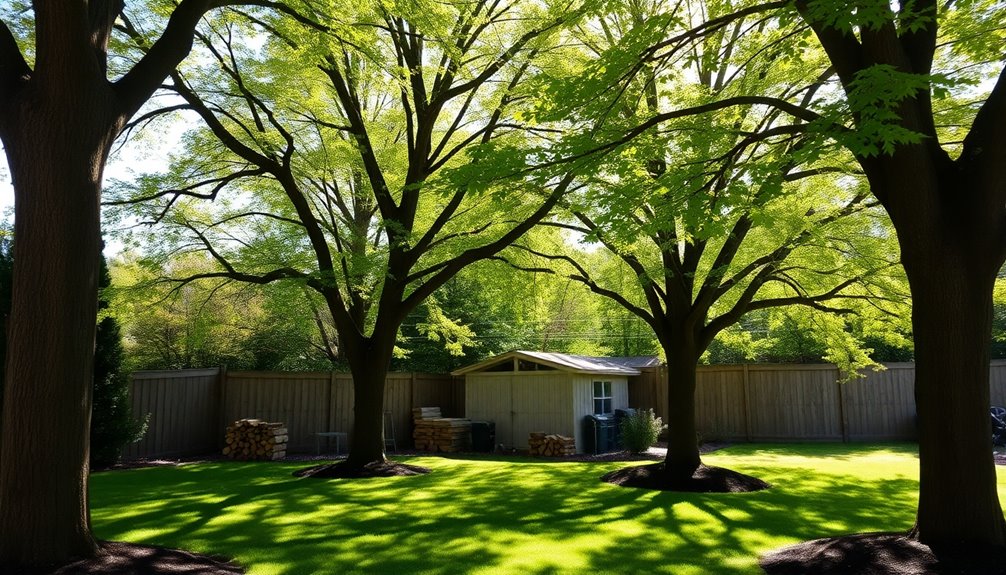
To protect your home during natural disasters, you need to keep your trees and landscaping in check.
Regularly prune overhanging branches, remove dead foliage, and assess the stability of your trees.
This proactive approach can substantially reduce the risk of damage from storms and high winds. Additionally, maintaining a wide color gamut in your landscaping can enhance the overall aesthetic and provide a sense of calm during stressful times.
Prune Overhanging Branches Regularly
Maintaining your trees and landscaping is essential for protecting your home from natural disasters, especially during stormy weather. Regularly pruning overhanging branches reduces the risk of storm damage, ensuring that even small branches don't cause significant issues to your roof or windows.
Here are some tips to keep in mind:
- Keep branches at least 10 feet away from your home to prevent contact during extreme weather.
- Inspect trees for signs of disease or decay, as weak trees are more likely to fall.
- Encourage neighbors to maintain their trees, creating a safer community.
Remove Dead Foliage
Removing dead foliage from your yard not only enhances your home's appearance but also greatly reduces hazards during natural disasters.
Regularly assess your landscaping for dead or dying branches, as these can become dangerous projectiles during high winds or storms. Be proactive and remove dead foliage and debris, which can fuel wildfires and increase fire risk around your property.
Prune trees, especially those near structures, to prevent overhanging branches from causing damage during severe weather. Consider the types of trees you have; some, like pines, are particularly vulnerable.
To protect your home effectively, maintain a defensible space by clearing away dead plants and keeping your landscaping tidy. Having a plan in place will guarantee your safety when disasters strike.
Assess Tree Stability
After clearing away dead foliage, it's time to assess the stability of your trees. Ensuring tree stability is essential for preventing property damage during storms.
Start by checking for signs of disease or weakness. Here are some tips to keep your outdoor space safe:
- Regularly prune large trees to remove any dead or weak branches.
- Inspect for leaning trunks or cracked bark; consult an arborist if needed.
- Trim overhanging branches that reach roofs or power lines.
It's also wise to maintain a defensible space around your property by keeping trees at least 30 feet from structures.
Encourage your neighbors to do the same for shared trees, as this collective effort can greatly reduce potential hazards during severe weather events.
Create an Emergency Plan and Kit
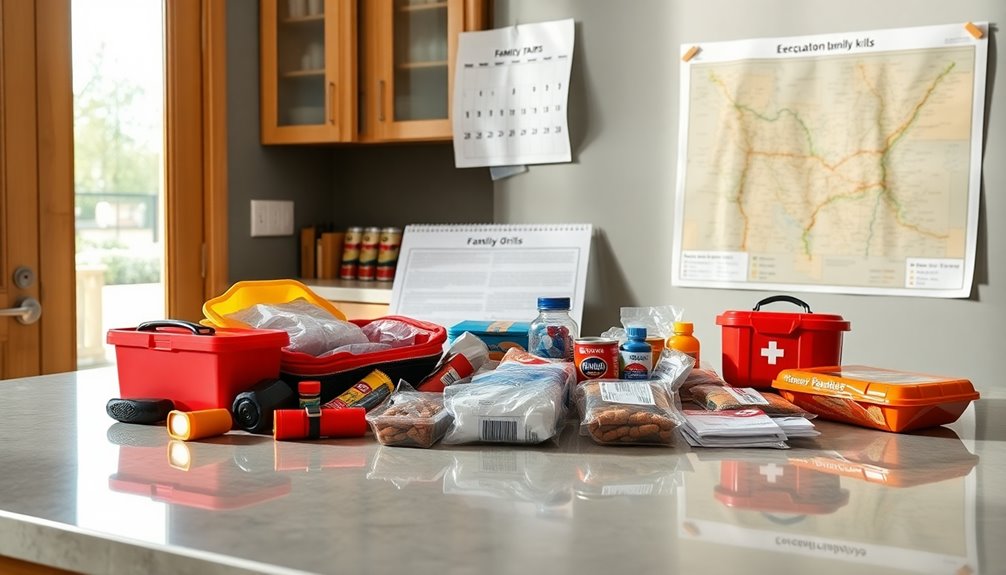
When disaster strikes, having a clear emergency plan and a well-stocked kit can make all the difference for your family's safety.
Start by developing an extensive emergency plan that outlines communication strategies and designated meeting places for your household members.
Next, assemble emergency kits that include at least three days' worth of non-perishable food, water (one gallon per person per day), and essential supplies like medications and first aid items.
Don't forget a battery-powered or hand-crank radio and a portable phone charger to stay informed during power outages.
Regularly review and update your emergency plan and kits, ensuring all supplies are up-to-date.
Practicing emergency drills at home will also help everyone understand the procedures during a crisis.
Elevate Valuables and Important Documents
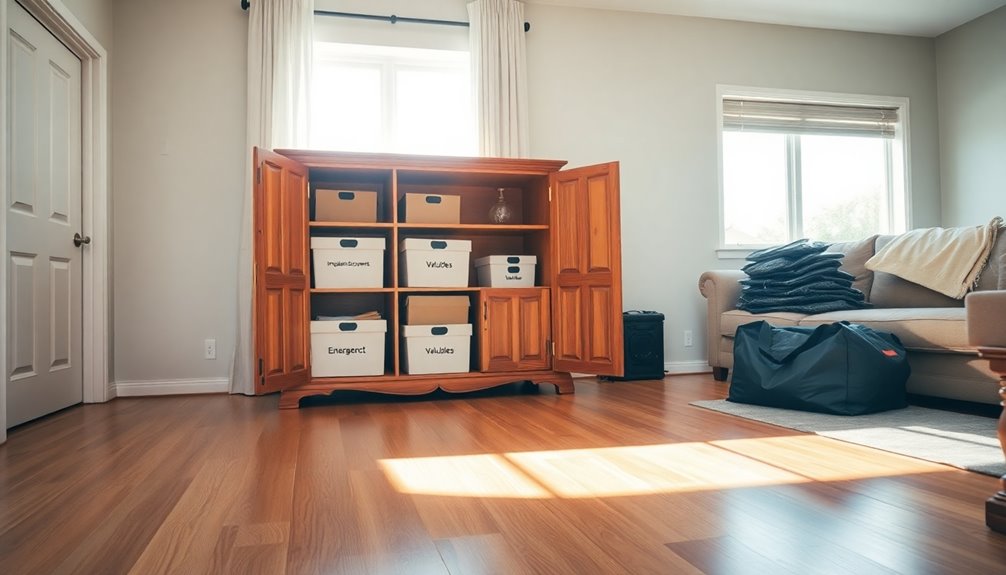
To protect your valuables and important documents from potential disaster damage, elevating them is crucial. By doing so, you greatly reduce the risk of water damage during flooding.
Here are some effective strategies:
- Elevate valuables like electronics and furniture at least one foot off the ground.
- Store important documents, such as insurance papers, in a waterproof, fire-resistant safe.
- Relocate items to a second floor or elevated surfaces to avoid floodwaters.
Additionally, consider using plastic bins to keep sensitive items organized and protected from moisture. Regularly assess and update your storage solutions to guarantee all critical documents and valuables are safeguarded before disaster season. Taking these steps not only provides peace of mind but also enhances your readiness for unexpected events.
Moreover, ensuring proper air quality management can further protect your health during disasters, especially in the aftermath when pollutants may be prevalent.
Frequently Asked Questions
How to Prepare Your Home for Natural Disasters?
To prepare your home for natural disasters, start by elevating important documents and valuables to higher areas.
Regularly prune trees and trim branches to minimize debris risks.
Reinforce garage doors and check mounting brackets for stability.
Create an emergency plan with clear evacuation routes and a safe meeting place.
Install storm shutters or board up windows, and secure outdoor items to prevent them from becoming projectiles during severe weather.
Stay proactive and informed!
What Are the 10 Steps to Disaster Preparedness?
Think of disaster preparedness as building a sturdy ship before the storm hits.
First, conduct emergency drills with your family. Next, create a disaster kit with essentials. Then, develop a thorough emergency plan, including evacuation routes and meeting places.
Secure important documents in a waterproof safe. Stay informed about local weather updates. Review and update your plan regularly. Check your supplies often. Make communication methods clear.
Finally, foster a community connection for support.
What Are the 10 Essential Survival Kit Items?
When you're putting together a survival kit, focus on these ten essential items: one gallon of water per person per day for three days, non-perishable food like energy bars or canned goods, and a thorough first aid kit.
Don't forget a flashlight with extra batteries, a multi-tool, a portable phone charger, and a battery-powered or hand-crank radio.
These items guarantee you stay hydrated, nourished, and informed during emergencies, boosting your chances of staying safe.
How to Make a House Natural Disaster Proof?
To make your house natural disaster-proof, you'll want to reinforce, elevate, and maintain.
Reinforce doors and windows with storm shutters or plywood to withstand high winds.
Elevate electrical systems and appliances above flood levels to prevent water damage.
Maintain your roof, gutters, and defensible space by trimming branches and removing debris.
Invest in flood-resistant materials to guarantee your home stands strong against nature's fury.
Preparedness starts with these proactive measures!
Conclusion
By taking these essential steps, you're not just preparing your home; you're transforming it into an impenetrable fortress against nature's wrath! Picture your doors and windows standing strong like a superhero, while sandbags laugh in the face of floodwaters. With your emergency plan and elevated valuables, you'll be ready for anything Mother Nature throws your way. So gear up, because when disaster strikes, you'll be the last one standing, sipping lemonade while others scramble!
